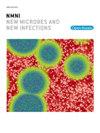Thelaziasis in humans: A systematic review of reported cases
IF 5.4
Q2 INFECTIOUS DISEASES
引用次数: 0
Abstract
Background
Thelaziasis is an emerging vector-borne zoonotic disease caused by Thelazia spp., which primarily affects animals but is increasingly recognised in humans, where it causes ocular infections. Human thelaziasis remains underreported and poorly understood in many regions despite its growing relevance.
Methods
This systematic review analyzed epidemiological, clinical, diagnostic, and therapeutic data from 134 documented human cases of thelaziasis reported across 18 countries. Data sources included peer-reviewed publications and case reports, focusing on identifying trends in geographic distribution, clinical presentation, diagnostic techniques, and treatment approaches.
Results
Most cases (82.8%) were reported in Asia, particularly in South Korea, China, India, and Japan. The most common symptoms were foreign body sensation (53%), conjunctival hyperemia (39.6%), and epiphora (33.6%). Infestation was unilateral in 90.3% of cases. Diagnosis was primarily made through direct visual identification of the parasite, while molecular confirmation was used in a limited number of cases. Thelazia callipaeda was the predominant species identified (88.8%). Manual extraction was the mainstay of treatment (88.8%), with antiparasitic agents used in selected instances. Reinfection occurred in 6% of cases.
Conclusion
This review underscores the growing recognition of human thelaziasis, particularly in Asia, and highlights the potential underdiagnosis in non-endemic regions. Environmental changes, globalization, and increasing human-animal interactions may facilitate the spread of the disease. Strengthening awareness, surveillance, and control measures is essential. Adopting a One Health approach, integrating human, animal, and environmental health perspectives, is critical for effective prevention and mitigation strategies.
人类寄生虫病:对报告病例的系统回顾
寄生虫病是由寄生虫引起的一种新出现的媒介传播的人畜共患疾病,它主要影响动物,但越来越多地认识到它在人类中引起眼部感染。在许多地区,尽管人类寄生虫病的相关性越来越大,但仍未得到充分报道和了解。方法本系统综述分析了来自18个国家报告的134例人类寄生虫病病例的流行病学、临床、诊断和治疗数据。数据来源包括同行评议的出版物和病例报告,重点是确定地理分布、临床表现、诊断技术和治疗方法的趋势。结果大部分病例(82.8%)发生在亚洲,尤其是韩国、中国、印度和日本。最常见的症状是异物感(53%)、结膜充血(39.6%)和眼显(33.6%)。90.3%的病例单侧感染。诊断主要通过对寄生虫的直接目视识别进行,而在有限数量的病例中使用分子确认。鉴定的优势种为黄颡鱼(88.8%)。人工提取是主要的治疗方法(88.8%),在选定的情况下使用抗寄生虫剂。6%的病例发生再感染。结论本综述强调了对人类寄生虫病的日益认识,特别是在亚洲,并强调了非流行地区潜在的诊断不足。环境变化、全球化和人与动物互动的增加可能促进疾病的传播。加强认识、监测和控制措施至关重要。采用“同一个健康”方针,综合考虑人类、动物和环境卫生的观点,对于有效的预防和缓解战略至关重要。
本文章由计算机程序翻译,如有差异,请以英文原文为准。
求助全文
约1分钟内获得全文
求助全文
来源期刊

New Microbes and New Infections
Medicine-Infectious Diseases
CiteScore
10.00
自引率
2.50%
发文量
91
审稿时长
114 days
 求助内容:
求助内容: 应助结果提醒方式:
应助结果提醒方式:


